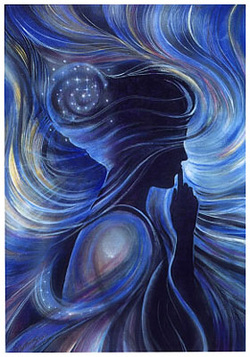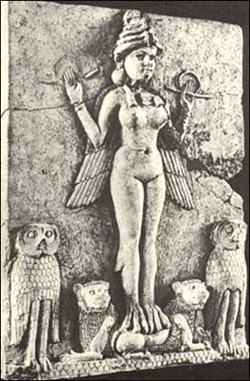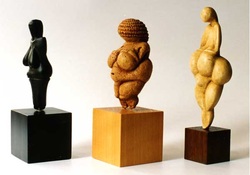The Feminine Divine: Goddesses

Goddesses are often typically affiliated with things of positive nature and connotation. The feminine mystique of the goddess, has her aligned with traits such as motherhood (maternity), fertility, domestics, eroticism and love in its purest state. However, even goddesses depicted as having a gentle disposition, also had war-like traits. The masculinization of the goddess figure makes for a broadened concept of femininity, as well as ables her to be associated with multiple facets within the culture and society she was worshipped in. Even goddesses such as Aphrodite, had strong war-like traits, but was later on romanticisized. Popularized goddesses, such as Athena, were worshipped by predominantly, a male audience and was a female figurehead that fought against the Amazons and advocated for patriarchy. Though she is seen as being a strong female figure because of her heavy association with war-in earnesty-during the time of her worship-she was a goddess for men. The goddess of the Amazons was Artemis.
In other religiosocietal realms, non-related to the mysticism of the Greco-Roman goddesses, are other powerful female divinities, such as the Valkryies: "Battle maidens and demigoddesses of Norse legend who, meeting in council in Valhalla, decided the outcome of battles." There is in addition a class of Nordic giantesses who serve as guardians, prophetesses and foes, such as Gefjon, Hringerth, Skadi, Gerda, Jord, Fenja, Gunnlod, Bestla, Ring and many others. Many of the Valkryies are elaborate branch-off corruptions of earlier Earth-Mother goddesses.
The Asynjor were guardians and attendants of Freya and Frigg or Nordic mythology. The Asynjor had strong resemblance to their Valkyrie-goddess counterparts. Many were giantess-goddesses, such as Fimila (an aspect of the goddess Frimla) and Fjorgyn, whose is mother of Frigga and Thor. There are over a dozen Asynjor-goddesses, more than they are standard Valkyries.
In other religiosocietal realms, non-related to the mysticism of the Greco-Roman goddesses, are other powerful female divinities, such as the Valkryies: "Battle maidens and demigoddesses of Norse legend who, meeting in council in Valhalla, decided the outcome of battles." There is in addition a class of Nordic giantesses who serve as guardians, prophetesses and foes, such as Gefjon, Hringerth, Skadi, Gerda, Jord, Fenja, Gunnlod, Bestla, Ring and many others. Many of the Valkryies are elaborate branch-off corruptions of earlier Earth-Mother goddesses.
The Asynjor were guardians and attendants of Freya and Frigg or Nordic mythology. The Asynjor had strong resemblance to their Valkyrie-goddess counterparts. Many were giantess-goddesses, such as Fimila (an aspect of the goddess Frimla) and Fjorgyn, whose is mother of Frigga and Thor. There are over a dozen Asynjor-goddesses, more than they are standard Valkyries.
Goddess Prototype: Lillith

In Hebrew legend, Lillith was created concurrently with Adam and therefore was a man's equal (unlike Eve). Due to her vitality and symbolic importance for women, she has been exceedingly villified in the millennia as a vampire, child eater and killer of men. She has been misinterpreted as a vindictive misandrist who casts out her fury as a catharsis for the contempt she harbors against Adam. She was called, "The Northerner," and may have some forgotten connection with the Valkyries. The Zohar supplement idenfities her with Bat Zuge (a divinity that flanks the left side of God's throne). Thus, it is persumed that she was amongst the fallen angels.
Kabalists identify her as a princess of Damascus, of the House of Rimmon, or as Queen of Zemargad. The Book Isaiah calls her, "the night hag," or "screech[ing] owl." Her emblems include the jackal, hyena, ostrich (suggesting the Egg-mother), owl (allowing for speculation of her connection with Greco-Roman Wisdom goddess, Athena), and carrion-eating kite. Her demon-lovers with satyrs.
She was believed sometimes to be accepted by God as his consort, displacing the rightful Queen of Heaven, Matronit-who ruled the Heavenly hosts as Lillith ruled the fallen. During these recurring periods of God's fascination, Israel becomes the lowest of all nations and is not restored until Matronit (or Shekinah) returns to her throne.
The 13th century Zohar ("The Book of Splendor") describes her [Lillith] as having: "frightful eyes, a drawn sword in her hand." Lillith, in demonized portrayals, is credited with causing stillbirths-just as with the greek goddess of the Hunt, Artemis. Though originally both were protectors of pregnant mothers and newborn babes.
Lillith was also recognized as the dark-face/side of the Assyrian Goddess Ishtar (whose mythology gives us the pagan origins of Easter. Ishtar being the Egg-Mother as Lillith was). She [Lillith] was also said to be the wife of Samael or Shaytan (identified in Christian dogma as Satan). She was wife of him, prior to being wed with Adam by the time of her creation.
As a serpent-goddess, she has been identified as the serpent of Eden, a harlot-temptress. A Kabalistic treatise of 1648 by Naftali Herz Bacharach, states that Lillith's husband was a castrate, associating her with the practices of the Phrygian mother-goddess Cybele. This also is a further indication that Samael was originally a goddess-consort (daemon), and that Lillith led the war in Heaven. Lillith goes by over a dozen other names and her traits can be found in every goddess after her ascension as the godess prototype. The most recurrent alternative name of Lillith, is Kali: the Protohistoric Goddess of Destruction. India was the epicenter of her worship,
Kabalists identify her as a princess of Damascus, of the House of Rimmon, or as Queen of Zemargad. The Book Isaiah calls her, "the night hag," or "screech[ing] owl." Her emblems include the jackal, hyena, ostrich (suggesting the Egg-mother), owl (allowing for speculation of her connection with Greco-Roman Wisdom goddess, Athena), and carrion-eating kite. Her demon-lovers with satyrs.
She was believed sometimes to be accepted by God as his consort, displacing the rightful Queen of Heaven, Matronit-who ruled the Heavenly hosts as Lillith ruled the fallen. During these recurring periods of God's fascination, Israel becomes the lowest of all nations and is not restored until Matronit (or Shekinah) returns to her throne.
The 13th century Zohar ("The Book of Splendor") describes her [Lillith] as having: "frightful eyes, a drawn sword in her hand." Lillith, in demonized portrayals, is credited with causing stillbirths-just as with the greek goddess of the Hunt, Artemis. Though originally both were protectors of pregnant mothers and newborn babes.
Lillith was also recognized as the dark-face/side of the Assyrian Goddess Ishtar (whose mythology gives us the pagan origins of Easter. Ishtar being the Egg-Mother as Lillith was). She [Lillith] was also said to be the wife of Samael or Shaytan (identified in Christian dogma as Satan). She was wife of him, prior to being wed with Adam by the time of her creation.
As a serpent-goddess, she has been identified as the serpent of Eden, a harlot-temptress. A Kabalistic treatise of 1648 by Naftali Herz Bacharach, states that Lillith's husband was a castrate, associating her with the practices of the Phrygian mother-goddess Cybele. This also is a further indication that Samael was originally a goddess-consort (daemon), and that Lillith led the war in Heaven. Lillith goes by over a dozen other names and her traits can be found in every goddess after her ascension as the godess prototype. The most recurrent alternative name of Lillith, is Kali: the Protohistoric Goddess of Destruction. India was the epicenter of her worship,
The Mother-Goddess Archetype

Monotheistic, divine feminine worship remains today (1. Neo-paganism, Wiccanry). The final remnant of mainstream goddess references would be the generic term of "Mother Nature." Which is used in affiliation with the elements of nature or is a divine personification of the entire Earth itself. The Venus Figurines, which is a vast array of goddess idols dating back 30, 000 years into the Neolithic and Paleolithic period, is what some historians and theologians believe to be evidence of a religio-matristic culture. The Mother-Goddess archetype has 3 specific traits. 1) Her body type is a conglomeration of rounded mounds and enhanced breasts. Her sexualization is a representation of her mass ability to reproduce. The large breasts or sometimes multiple breasts, is an indication of her procreative power and is a sign of fertility. 2) She signifies motherhood. As having the ability to reproduce, all her offspring put her into a maternal position. Assuming that she also guards the sacred conception. 3)She has no elaborate facial features. This allows for an easier relation with all women.
Many other goddesses hold onto the concepts of maternity and fertility. These two themes being the guiding themes for worldwide goddesses. Though, there is a contradiction in which many goddesses also have sadistic traits and adhere to the call of war. These Neolithic goddess figurines, found throughout the world, are definite evidence that goddess worship predates god worship, but in reality, tell us nothing of early social or jural systems.
Many other goddesses hold onto the concepts of maternity and fertility. These two themes being the guiding themes for worldwide goddesses. Though, there is a contradiction in which many goddesses also have sadistic traits and adhere to the call of war. These Neolithic goddess figurines, found throughout the world, are definite evidence that goddess worship predates god worship, but in reality, tell us nothing of early social or jural systems.
